Imagine a frozen lake which, upon melting each year, reveals the unnerving sight of the remains of more than 300 people. A small lake known as Roopkund Lake sits high in the Indian Himalayas, more than 16,000 feet (4,900 meters) above sea level. Covered in ice and surrounded by rocky glaciers, the lake appears to be a typical, albeit beautiful, natural wonder. However, during one month of the year, when the ice melts away and the bottom of the shallow lake becomes visible, the true nature of the lake reveals itself. At the bottom of the lake are hundreds of mysterious human skeletons.
There have been efforts to determine who these people were, where they were from, and how they died, buy many questions still remain unanswered about the skeletons at Roopkund – now referred to as Skeleton Lake.
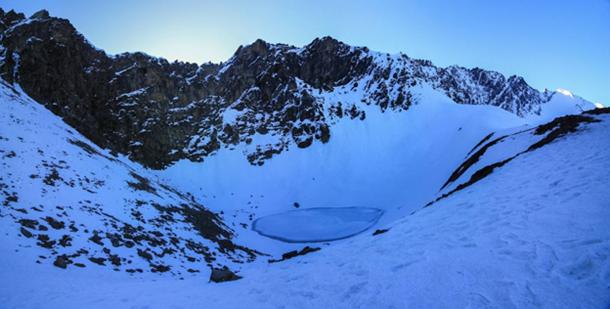
Roopkund Lake lies in the harsh terrain of the Himalayas. ( Uttam /Adobe Stock)
Where is Roopkund Lake?
Roopkund Lake is located at the bottom of a small valley in the Himalayas, in Chamoli district, Uttaranchal, in India. The lake is very shallow, with its greatest depth at approximately 2 meters (6.56 ft.)
The area is a popular destination for adventurous tourists, due to the spectacular trek it takes to get there. There are several trekking routes on the way to Roopkund, which many take advantage of for the picturesque view, and to satisfy the curiosity and intrigue surrounding the skeletal remains.
A Lake Full of Dead Bodies
The first reports regarding the skeletal remains date to the 19th century, but the remains were re-discovered by Nanda Devi game reserve ranger H K Madhwal in 1942. He found a few of the skeletons at the bottom of the lake while it was frozen. As summer came, and the frozen lake melted, more skeletons were revealed in the lake and around the edges. It is believed that the skeletons number around 300.
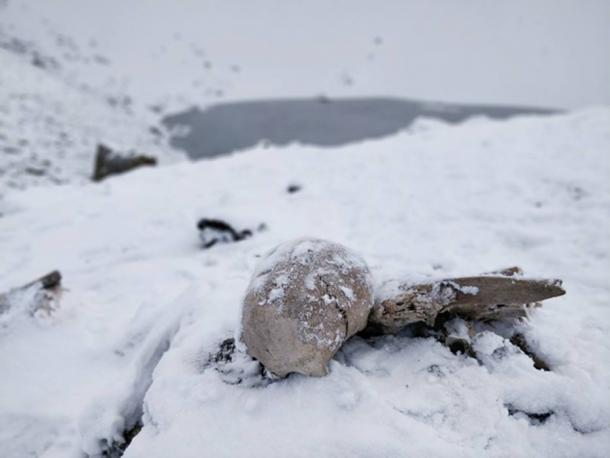
Naturally preserved ancient human skeletons under snow. (Anuroop /Adobe Stock)
When the discovery was made, there was no information available about the remains. No one knew who the skeletons belonged to, how long they had been there, or what had happened to them. Since the skeletons had been rediscovered during World War II, the first assumption was that these were the skeletons of soldiers , perhaps Japanese soldiers who had died from exposure to the elements while traveling through India.
Due to this possibility, determining the source of the remains became a priority. A team of investigators was sent to Roopkund, where they quickly determined that the remains were too old to be from the ongoing war. With the immediate concerns of war being eased, the urgency of identifying the remains became less of a priority and efforts to further analyze the remains were sidelined.
With later investigation, it became apparent that the remains consisted of more than just bones. The frigid temperatures and dry, cold air allowed bits of flesh, nails, and hair to be preserved as well. In addition, pieces such as wooden artifacts, iron spearheads, leather slippers , and jewelry were discovered.
Oxford University’s Radiocarbon Accelerator Unit conducted radiocarbon dating on the remains and concluded that they date back to around 850 AD. Without any evidence of a nearby settlement, it is believed that the individuals were traveling when they died.
But what caused their death? Was there a massive landslide? Did some disease strike suddenly? Were the individuals conducting a ritualistic suicide? Did they die of starvation? Were they killed in an enemy attack? One theory even suggests that the individuals did not die at the scene of the lake, but their bodies were deposited there as a result of glacial movement.
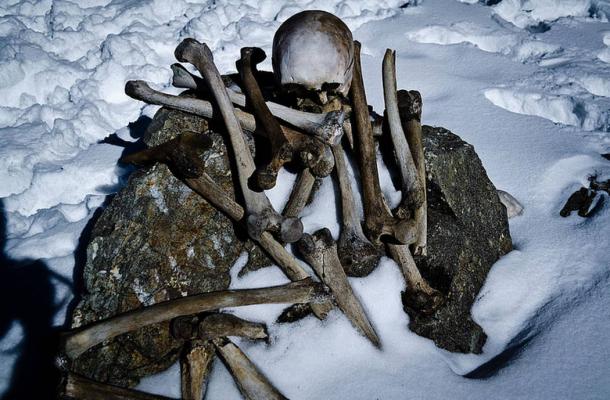
Human skeleton found at Roopkund Lake. (Credit: Saibat Adak )
The Legend of Skeleton Lake
There is a local legend that may shed some light on the identity of the remains. It states that Raja Jasdhaval, the king of Kanauj, was traveling with his pregnant wife, Rani Balampa. They were accompanied by servants, a dance troupe, and others as they traveled on a pilgrimage to Nanda Devi shrine, for the Nanda Devi Raj Jat, which takes place every 12 years.
As they traveled, the legend says the group was struck down with “iron balls thrown from the sky” by an angered deity. Researchers suggest those “iron balls” could refer to extremely large hail stones that suddenly overcame the travelers.
The storm was too strong, and with nowhere to take shelter, the entire group perished near Roopkund. For a long time this story appeared to be a legend, with no evidence to substantiate it. However, recent finds may lend some support to the legend. For example, parasols that may have been used during a procession” were discovered strewn among the human remains, and some of the skulls have unhealed fractures, which massive hailstones might have caused.
Where are the Roopkund Lake Bodies From?
By 2013, researchers concluded that it likely that the individuals had been killed in a hail storm. The injuries on the remains indicate that each person was killed by one or more blows to the head, neck, and shoulders. There do not appear to be injuries on any other parts of their bodies, which rules out death by landslide, avalanche, or weapons. However, there has been no verification as to whether this was a group traveling with the king of Kanauj, as legend states.
But there is more to the story when researchers look at the ancient genes. In the early 2000s, the scientists who had studied the bodies’ DNA determined that the people were of South Asian ancestry , and that they had all died in a single event around 800 AD. However, a 2019 study stated that, “full genomic analyses from 38 sets of skeletal remains upend that story.”
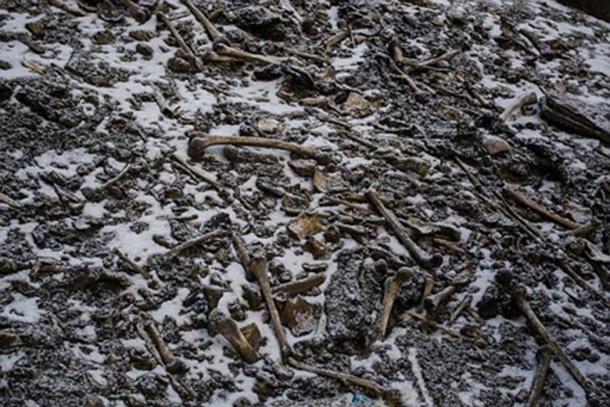
Human remains at Skeleton Lake. (Atish Waghwase/ Nature)
The new report says the people were “also found to have genetic ties to the Mediterranean, Greece, and Crete, and that nobody was related to each other”. The scientists also found “another group of 14 victims” who they believe had died “a thousand years later in a single event” in the 17th and 20th centuries AD.
However, Kathleen Morrison, chair of the anthropology department at the University of Pennsylvania, does not see much of a problem or fascination with the recent study results, stating that “the least interesting thing about the specimens at Roopkund is where in the world their DNA says they came from.” She pointed out that a “ Hellenic kingdom existed in the Indian subcontinent for about 200 years, beginning in 180 BC” and that “some unknown group of Mediterranean European people is not really a big revelation.”
So, the mystery behind identity of the skeletons at Roopkund Lake continues.
Stealing from the Past
Today, there are other concerns about Roopkund. Many trekkers have traveled there to see the remains and several of them get there by mule. There are even tourists that take bones and skeletons with them as they leave. The large numbers of visitors and the mules trekking through the area bring concerns of damage to the remains that are there.
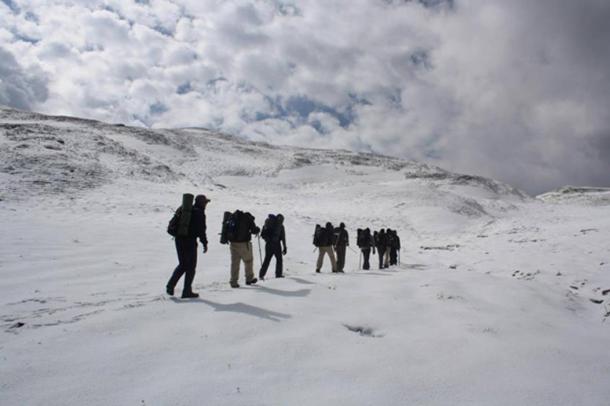
Trekkers making their way to Roopkund in the Himalayas. (Djds4rce / CC BY-SA 3.0 )
Of course, the most pressing worry is the removal of the skeletal remains. While some information has been determined about the individuals over the years, there may be much more data to uncover. Unfortunately, this possibility decreases as more and more remains are destroyed and removed.
Efforts have been made to protect that area as an eco-tourist destination, so people can still view the wonders of Roopkund, without risking destruction or removal of the skeletons. Preserving the possibility of further research is essential if there is going to be hope of learning more about the mysterious group of people that were killed over a millennia ago in the Himalayas.
Top Image: Ancient human skeletons found beside high altitude Roopkund Lake, aka Skeleton Lake, in the Indian Himalayas. (Schwiki/ CC BY-SA 4.0 )
By M R Reese
Updated on September 2, 2020.
 RSS Feed
RSS Feed















 September 3rd, 2020
September 3rd, 2020  Awake Goy
Awake Goy  Posted in
Posted in  Tags:
Tags: 













